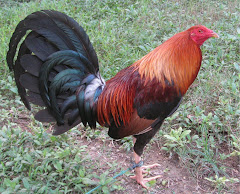Sunday, November 1, 2009
Llamado Tayo: Iba ang Pinoy
Iba ang Pinoy
Talagang napakalaki ng pinsalang iniwan ng bagyong Ondoy sa Metro Manila at ng Pepe sa north Luzon. Nandoon ngayon sa Tuguegarao si kamanang Marlon Mabingnay at saksi siya sa bakas ng hagupit ni pepe.
Nandoon si kamanang Marlon upang tumulong sa paghanda ng mga stags ng JT Northern Star farm nina kamanang Jun Ramos. Sabi ni Marlon sa farm lang mismo malaki ang na damage.
Pero, talagang makikita rin natin ang tibay ng Pilipino. Pagkatapos ng pagkatapos ng bagyo agad tayo ay nagsusumikap na makabangon. Ang mga sabungero, naghahanda pa agad sa susunod na laban. Iba talaga ang Pinoy.
Marami sa ating mga kamana ang na wiped-out ang kanilang mga manok sa magkasunod na bagyo at sa baha na idinulot ng mga ito. Ang una nilang ginawa ay ang maghanap ng materyales upang makapagsimula muli. Talagang game na game. Hindi susuko.
Sa mga kamana natin na interesado sa gamefowl dispersal program ng MANA, manatili lang nakatutok sa tilaok.blogspot.com sa internet. Maglalagay tayo doon ng mga impormasyon hinggil sa programang ito. Patuloy ding magbasa sa pitak nating ito dito sa Larga.
Sa ngayon may 300 hens na tayong nakahanda para sa breeding season. Baka madagdagan pa ang mga ito kung may iba pang kamana nating breeders na sasali sa programa. Ang breeder na sasali sa programa ay magkakaroon ng feeds subsidy galing sa isang kumpaniya ng feeds. Kapalit nito ay magbibigay siya sa MANA ng breeding materials para magamit ng dispersal program.
Ipagpatuloy natin ang pagtalakay sa lahing lemon. Ang susunod ay bahagi ng artikulong isinulat natin para sa Pit Games magazine noong taong 2005.
Lance: In negros you are not a breeder
if you have got no lemons
Inasmuch as you cannot start a story about the lemons without mentioning Paeng Araneta, certainly, you could not end it without reference to Lance de la Torre.
Lance, the big boy who rose from the ranks. The former policeman who resigned from service to pursue a much greater love of his—cockfighting.
He went to Manila to condition, handle and tie the knife on the chickens of prominent cockers.
In due time, he proved his worth.
He found a partner and he was suddenly into breeding, and, became a world slasher champion, the first to score 8 straight wins in the wsc.
Lance’s lemons are of the Nonoy Jalandoni and Nene Velez variety. Not much different from those of Juancho Aguirre and the rest of the La Carlota group. His lemons are probably the most expensive around, but like the Rolls Royce, they are worth every penny, even more.
His lemons blend well with his roundheads, and with most of his other lines. Straight combed, and medium stationed, they come with some shades of malatuba in the breast. They look like the old time lemons but they pack more wallop and are quicker than most. They are really a wonder to behold.
When I was in Lance’s farm, in Talisay, Negros Occ., I was treated to a long sparring session. The lemons were sparred along side his newly acquired bloodlines such as the much sought after Jr. Belt Cowan roundhead, as well as his old reliables such as his boston and his regular roundheads. There were also his hatches and his greys, the lance greys that sold for more than a hundred grand a trio.
Against this formidable array of distinguished bloodlines, Lance’s lemons held their own.
The master breeder in lance has somehow managed to infuse the much needed booster to enable his lemons fight as fit for the modern times.
His lemons are intelligent, quick and powerful. Considering Lance’s obsession with gameness, we can be rest assured too that his lemons are more than fairly game.
Lance, the man who said that: “you are not a breeder if you don’t have the lemon,” also admitted to this writer: “I am not an all out lemon fanatic, I know the limitations of the lemons but I know its blending value too.”
The lemons’ attributes and records
Known for its brainy fighting style, accurate cutting ability and excellent timing, the lemon is, without doubt, one of the great bloodlines in the history of cockfighting.
After forty years of remarkable presence in the Philippine cocking scene, the lemons have definitely passed the test of time, and with flying colors.
Despite the advent of the so-called modern yellow legged and green legged hatches, the super kelsos, the magnum and bonecrusher hatches, the numerous variations of the old time roundheads, and other newly created or revitalized old strains, the lemons are still sought after by top notch breeders who know of the lemons’ value.
The lemons first caught the attention of the international cocking community in 1972. That year the lemon 84s of Paeng Araneta won the international derby. The 84s were the only local breed entered in that grand event.
Another high point of the lemons came in 1997 when Lance de la Torre, in tandem with Patrick Antonio, won solo that year’s edition of the World Slasher Cup II. Lance de la Torre unveiled to the world the might and ring savvy of his lemon-roundhead crosses to score 8 straight victories. It was then an unprecedented feat.
Prior to that no one had ever scored 8 straight wins in the WSC. The record was eventually tied 7 years later by Rudy Salud and Lito Orillaza who copped the 2004 edition of world slasher cup I. Salud and Orillaza showed cocks coming from bloodlines of another Negros stalwart, Danilo Hinlo.
In year 2000, Bob Cuenca, a member of the La Carlota, Negros lemon group, likewise in tandem with Patrick Antonio, won a share of that year’s January edition of the world slasher.
That same year, Peping Ricafort scored a grand slam. He emerged co-champion in both the January and June editions of the world slasher cup. Ricafort later divulged in a magazine interview that he always made it a point that all cocks he bred have drops of the lemon 84 blood which he got directly from the originator Paeng Araneta.
In January 2001, Tony Trebol, another member of the La Carlota lemon group won another WSC title.
These series of major achievements by the lemons were no easy feats considering they came in the wake of perennial challenges from the sweaters of Carol Nesmith, Bruce Barnette, and Dink Fair, the Roger Roberts hatchets; and the birds of Johnny Jumper, Ray Alexander, and those of many other American and local breeders.
Brainy and quick
The lemons are medium to low station. They fight smart, cut well and have excellent timing. They come in plumage from red with lemon hackles to downright lemon like color. They come either in straight or pea combs, but mostly straight combs, except for the 84s which are basically pea combs. More than ninety percent of the lemons come in yellow legs. A few are green legged. Fewer still are white legged. They are not as beautiful as, say, the sweaters, but the lemons have a bearing of the royalty and confidence of a champion. The lemons exude an aura, so to say.
In the pit, they keep their cool under extreme pressure. Under attack, the lemon extricate itself by either gracefully side stepping or topping the opponent. When attacking, the lemon does not resort to fancy shuffles and multiple cutting. It simply hits with fatal single strokes.
The lemon may not look so fast in its movements but, in reality, it is quick to the draw and extremely accurate. There is rhythm to its blows that draws the opponent to its beat, and poetry in its motions that baffles the opponent into lowering its guards.
The lemons are patient and brainy. They are what is called “abang” in Tagalog and “kumpas” in Bisaya. They wait for the opponent to make the first move. They seem to know that, more often than not, the first move is a mistake.
Then the lemons are vertical flyers. When the other cock strikes the lemon goes up vertically to top the opponent, and not diagonally as most cocks do.
This is geometry and physics in action. When two birds go up together in the air vertically, the point of contact is prolonged and gravity more centered that when one of the birds breaks diagonally forward. Thus, breaking vertically, the bird on top will have more time to inflict damage; whereas, in a diagonal flight the inertia of the forward blow will likely prevent the blade from going deeper into the flesh.
On the ground, when evading blows, the lemon side steps or back pedals instead of ducking. And, it counters accurately. According to Mayor Juancho Aguirre, to him the ultimate maneuver of a cock is back pedaling at the same time “nagiiwan ng paa” or counter striking effectively. “The lemon can do it, can do it in style,” he said.
Also the lemons are not bill holders. They strike with their feet not with their beaks. They have this staccato type of blows that seem to always beat the opponent to the draw. In breeding, too, the lemon blends well with almost any other bloodline.
Welcome. To read the articles, please click post link or month, then subsequent post link.
-
▼
2009
(71)
-
▼
November
(9)
- MANALU sets feeding of street children
- Gamefowl's natural biorhythm: A study by RB Sugbo ...
- Probiotics for chickens
- Llamado Tayo: Sugbo Agro
- Llamado Tayo: Malungkot na pangyayari
- Llamado Tayo: Ang Lemon
- Llamado Tayo: Iba ang Pinoy
- Llamado Tayo: Sa sabong hindi sugal ang mahalaga
- Llamado Tayo: 3 cocks sa Baras, Rizal
-
▼
November
(9)
Ponkan broodcock

One of the ponkan broodcocks being readied by RB Sugbo for the incoming breeding season. RB Sugbo is among the gamefowl farms very much involved in the Masang Nagmamanok (MANA) Inc. nationwide gamefowl dispersal program.
Another ponkan

Another ponkan broodcock in the trio pen.
Mana: Dami at Pagkakaisa
Walang duda napakalaki na ng pinagunlad ng sabong mula sa paging libangan tuwing araw ng Linggo, ito ngayon ay isa nang napakatanyag na isport, malaking industriya at kaakitakit na mapagkakitaan.
Napakarami nang nagpapalahi ng manok panabong. Nagsilabasan ang mga babasahin at programa sa telebisyon ukol sa sabong.
Sa bawat nagpapalahi, ilan ang tagapagalaga ng kanyang manok? Sa bawat may-ari ng sabungan, ilan ang naghahanapbuhay sa sabungan niya? Sa bawat kasali sa derby, ilan ang nagbabayad sa pinto upang manood? Sa bawat malaking sabungero, ilan ang mayroon lang iilang pirasong tinale sa kanilang bakuran? Dapat lang, at napapanahon na siguro, na ang masang sabungero ay mapagtuonan ng pansin, mabigyan ng kinatawan, at, marinig ang boses sa isport at industriya ng sabong.
Ito ang nais abutin ng MANA (Masang Nagmamanok), isang pambansang kilusan at samahan ng mga masang sabungero. Ang mga layunin ng MANA ay ang sumusunod:
1. Ang pangalagaan ang kapakanan ng mga maliit na sabungero, partikular na, ang mga naghahanapbuhay sa sabungan. Inaasam na sa darating na panahon, ang mga handlers, mananari, casador, kristos, sentensiyador, farm hands ay magkakaroon ng mga benepisyo tulad ng insurance, pension at iba pa.
2. Ang mapatingkad ang kaalaman ng ordinaryong sabungero sa pagmamanok. At, sila’y mabigyan ng pagkakataon na magkaroon ng angkop na materyales sa pagpapalahi at paglalaban.
3. Ang ipaglaban ang sabong sa gitna ng banta na itoy gawing labag sa batas tulad ng nangyari kamakailan lang sa Estados Unidos, at ipreserba ito bilang isport, hanapbuhay, industriya at bahagi ng ating kultura at tunay na mana.
4. Ang magtulungan at makipagtulungan sa iba pang haligi ng industriya sa ikabubuti ng sabong at ikauunlad ng lahat na mga sabungero.
Inaasahan na matupad ng MANA ang nasabing mga layunin pamamagitan ng pagpakita ng dami at pagkakaisa.
Ang pagkatatag ng MANA ay bunsod ng mungkahi ni kamanang Boying
Ang Llamado Tayo ay tumatalakay sa ibatibang aspeto sa pagmamanok at binabasa ng napakarami arawaraw, kaya di nagtagal marami ang sumapi sa MANA.
Kasunod nito, ang MANA ay nakapagpaseminar sa ibatibang lugar at rehiyon ng Pilipinas, sa tulong ng mga kumpaniya tulad ng Excellence Poultry & Livestock Specialist, Bmeg-Derby Ace, Sagupaan, Secret Weapon, at Thunderbird.






